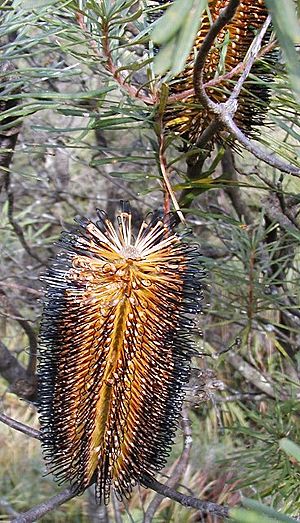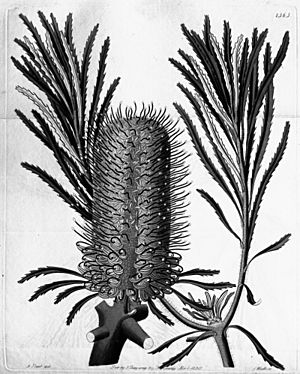Banksia spinulosa var. cunninghamii facts for kids
Quick facts for kids Banksia spinulosa var. cunninghamii |
|
|---|---|
 |
|
| Scientific classification |
|
| Kingdom: | Plantae |
| Clade: | Tracheophytes |
| Clade: | Angiosperms |
| Clade: | Eudicots |
| Order: | Proteales |
| Family: | Proteaceae |
| Genus: | Banksia |
| Species: | |
| Varietas: |
B. s. var. cunninghamii
|
| Trinomial name | |
| Banksia spinulosa var. cunninghamii (Sieber ex Rchb.) A.S.George
|
|
Banksia spinulosa var. cunninghamii, sometimes called Banksia cunninghamii, is a type of shrub or small tree. It grows along the eastern coast of Australia, in areas like Victoria and New South Wales. This plant grows quickly and is sometimes grown in gardens. Unlike some other Banksias, it does not have a special woody swelling at its base called a lignotuber.
What Does It Look Like?
Like other types of B. spinulosa (which is also known as Hairpin Banksia), this plant grows as a shrub with many stems. Its flower spikes are usually golden. Some might also have red or purple parts. The leaves, flowers, and fruit look very similar to the New England Banksia. However, B. spinulosa var. cunninghamii is special because it does not have a lignotuber. A lignotuber is a woody swelling at the base of the plant. It helps the plant regrow after a fire.
How Did It Get Its Name?
Scientists give plants names to help us understand them better. This plant was first collected in 1823 by Franz Sieber. He found it near Mount York in the Blue Mountains of New South Wales. Sieber named it Banksia cunninghamii to honor Alan Cunningham, who was also a botanist.
In 1827, Ludwig Reichenbach officially described the plant. For a long time, it was known as Banksia cunninghamii. Later, in 1870, a scientist named George Bentham thought it was the same as another plant, Banksia collina.
Then, in 1981, Alex George studied Banksias again. He decided that Banksia cunninghamii was actually a variety of Banksia spinulosa. So, its name became B. spinulosa var. cunninghamii. This means it's a specific type within the Banksia spinulosa group.

Today, many scientists follow Alex George's way of classifying Banksias. Here is how B. spinulosa var. cunninghamii fits in:
- Genus Banksia
- Subgenus Banksia
- Section Oncostylis
- Series Spicigerae
- Section Oncostylis
- Subgenus Banksia
*'''B. spinulosa **B. spinulosa var. spinulosa **B. spinulosa var. collina **B. spinulosa var. neoanglica **'''B. spinulosa var. cunninghamii
Some scientists, like Austin Mast, are still studying Banksias using DNA information. Their studies might change how these plants are grouped in the future. For now, the National Herbarium of New South Wales still calls it B. cunninghamii.
Where Does It Grow?
This plant grows along the coast from Melbourne, Victoria all the way to the northern border of New South Wales. You can find many of these plants east of Melbourne. They also grow along the coast near the border of Victoria and New South Wales, and around Sydney.
It mostly grows in sandy soil, often where there are rocks. But it can also grow in heavier soils. You will usually find it as a smaller shrub under taller Eucalyptus trees in open forests and woodlands.
How to Grow It
B. spinulosa var. cunninghamii is a fast-growing shrub. It can start flowering about five years after you plant its seeds. The flower spikes are pretty, but sometimes the leaves hide them.
This plant likes soil that drains well, even if it's a bit heavy. It also prefers some shade. It can handle cold weather, even frosts down to about -8°C (18°F). If you prune it, only cut a little bit. Make sure you don't cut below the green leaves.

